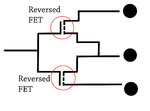Dismantle.Repair
Newbie level 3

Hi everyone,
This is my first post! (This is also my first real project for college)
The aim of this project is to write a piece of software that controls an Arduino and in turn control various DI Box switches.
I've de-soldered the first switch and the logic is as follows:



I wondered if it would be possible to use a logic n-MOSFET and a logic p-MOSFET to make the connections. (Obviously the same system would need to be employed on the left and right hand side) - This way one logic 5V signal from an Arduino would supposedly make these connections.
At the same time I was recommended by another person that a DPDT relay switch would be a good solution.
Any advice/comment on which is the best solution would be extremely helpful.
This is my first post! (This is also my first real project for college)
The aim of this project is to write a piece of software that controls an Arduino and in turn control various DI Box switches.
I've de-soldered the first switch and the logic is as follows:



I wondered if it would be possible to use a logic n-MOSFET and a logic p-MOSFET to make the connections. (Obviously the same system would need to be employed on the left and right hand side) - This way one logic 5V signal from an Arduino would supposedly make these connections.
At the same time I was recommended by another person that a DPDT relay switch would be a good solution.
Any advice/comment on which is the best solution would be extremely helpful.
